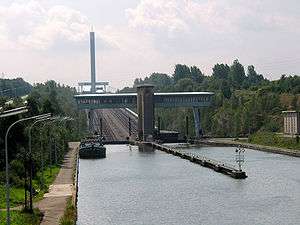Canal inclined plane
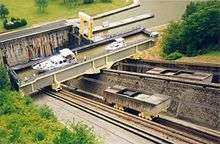

An inclined plane is a system used on some canals for raising boats between different water levels. Boats may be conveyed afloat, in caissons, or may be carried in cradles or slings. It can be considered as a specialised type of cable railway.
An inclined plane is quicker, and wastes less water, than a flight of canal locks, but is more costly to install and operate. A development of the idea is the water slope. Another alternative to consecutive locks is a boat lift.
Operation
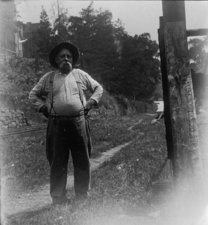
Typically, such a feature consists of a slope, with one or more rail tracks on it. Boats are raised between different levels by sailing into water-filled tanks, or caissons, with wheels on the bottom and watertight doors at each end, and are perpendicular to the slope. These are drawn up or down hill on the rails, usually by means of cables pulled by a stationary engine. In most designs two caissons are used, one going up and one down, acting as counterweights for greater efficiency. When the caisson has reached the top or bottom of the slope, the doors open and the boat leaves.
There are also inclined planes without a tank or caisson, instead carrying vessels up out of the water cradled in slings or resting on their keels. In a few cases the boats were permanently fitted with wheels.
History
Inclined planes have evolved over the centuries. Some of the first were used by the Egyptians to bypass waterfalls on the Nile.[1] These consisted of wooden slides covered with silt which reduced friction.[1]
Timeline
- 600BC – The Diolkos, an early Greek inclined plane, was in use.[2]
- 385AD – Inclined planes were in use on the Grand Canal in China.[2]
- 1167 – Nieuwedamme overtoom (a simple type of incline) was built at Ypres.[3]
- 1568 – Wagon of Zafosina in use near Venice.[3]
- 1773 – John Edyvean proposes the use of inclined planes on the St. Columb Canal in Cornwall, UK.
- 1773 – Inclined planes proposed on the projected Caldon Canal. (See Peter Lead,The Caldon Canal, Oakwood Press 1990.)
- 1777 – 3 inclined planes or 'dry wherries' begin operation on Dukart's Canal, near Coalisland, in the south-east of County Tyrone in Ulster.[4] The inclines were a failure and were dismantled by 1787.
- 1788 – An inclined plane is built by William Reynolds and used, for the first time in England, to raise canal boats on England's Ketley Canal.[5][6]
- 1792 – William Reynolds of Ketley Ironworks constructed several inclined planes on the Shropshire Canal.[5][7]
- 1792 - 1921 – In 1792 the Shropshire Tub Canals were built incorporating a number of inclined planes. One of these, the Trench plane closes in 1921 and brings to an end boat carrying inclined planes in Britain [4]
- 1793 – American born inventor Robert Fulton wrote a letter to Lord Stanhope suggesting inclined planes instead of locks for Bude Canal in Cornwall. Lord Stanhope replied saying his idea for working the plane had already been thought of by Edmund Leach.
- 1794 – Robert Fulton took out a British patent (# 1988), for improvements to inclined planes including a double inclined plane system to be used to raise canal boats without locks.
- 1795 - 1805 – South Hadley Canal begins operations, on the Connecticut River in Massachusetts, United States. The first North American inclined plane canal. Replaced by five locks in 1805.
- 1797 - 1822 – At Worsley Navigable Levels, a coal mine operation in Greater Manchester, England, an underground incline started in 1795 was completed in 1797.[3]
- 1800 – Francis Henry Egerton (1756-1829), who became The 8th Earl of Bridgewater in 1823, wrote 'The Description of the Inclined Plane at Walkden Moor. (Lancashire)'
- 1801 - 1806 – Inclined plane built on the Somersetshire Coal Canal , connecting a coal mining region to the Avon Canal. Temporary while a system of 22 locks augmented by a pump were installed. Canal ceased operation in 1893.
- 1806 - 1828 Two inclined planes built on the Stollen Canal at Gliwice, Upper Silesia.[3]
- 1806 – Three inclined planes built on the Canal du Creusot near Torcy, France.
- 1823 - 1891 – Bude Canal completed in 1823 incorporating six inclined planes along which tubs with wheels were transferred between different levels of the canal.
- 1827 - 1871 – The Rolle Canal in North Devon, England included an inclined plane. The canal was closed in 1871 to make way for a railway.
- 1831 - 1924 – Between 1825 and 1831, 23 inclines were built as part of the Morris Canal, New Jersey, USA.[5] This waterway, 100 miles (160 km) long, connected the Hudson and Delaware Rivers, rising more than 1,400 feet (430 m). In 1832, Mrs. Frances Trollope*, publishes in "Domestic Manners of the Americans" her account of a visit the previous year to see one of the inclined planes of the Morris Canal. In 1924 the canal was abandoned and later dismantled. The Morris Canal's design was reused for the planes on the Elbląg Canal[8] (see below).
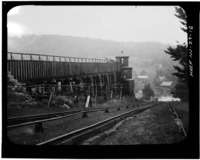 Inclined plane 7 West on Morris Canal, showing flume, powerhouse, cabling, and track. Cradle can be seen at bottom in the canal. Note how return cable is on wooden stands with pulleys
Inclined plane 7 West on Morris Canal, showing flume, powerhouse, cabling, and track. Cradle can be seen at bottom in the canal. Note how return cable is on wooden stands with pulleys - 1834 - 1857 - The Allegheny Portage Railroad, consisting of 36 miles of track traversing 10 incline planes and the first railroad tunnel in the United States, opens in Pennsylvania as part of the Main Line of Public Works allowing barge traffic to travel between Philadelphia and Pittsburgh over the 1,399 foot (426 m) Allegheny Front. In 1857 a new railway between Philadelphia and Pittsburgh had taken over the function of the canal.
- 1837 - 1865 – The extension to the Kidwelly and Llanelly Canal, Wales opens in 1837, including two counterbalanced inclined planes and one single-track one.[9] The canal is replaced by a railway in 1869,
- 1849 - 1942 – Inclined plane built on the Monkland Canal near Blackhill, Scotland to supplement existing locks.[5]
- 1860–present – The first four inclined planes of the Elbląg Canal in Germany (East Prussia), nowadays Poland, were opened in 1860.[5] A fifth incline was added later to replace five wooden locks. This canal reused the design from the Morris Canal for its inclined planes.[8]
- 1885 - 1948 – Keage Incline on Lake Biwa Canal in Kyoto, Japan. By 1948 a railway and road had taken over the function of the canal.
- 1900 - 1926 – Foxton Inclined Plane was built in England to help overcome shortcomings of the Foxton locks on the Grand Union Canal. Mothballed in 1911 and seeing only occasional use and dismantled in 1926.[5]The track of the Foxton Inclined Plane, which is no longer in use
- 1917 - 1923 – Big Chute Marine Railway in Ontario, Canada was built as part of the Trent-Severn Waterway. Replaced in 1923 by larger inclined plane able to carry boats up to 60 feet.
- 1919 - 1965 – Swift Rapids Marine Railway in Ontario, Canada was built. Replaced in 1965 by canal lock.
- 1923 - 2003 – Big Chute Marine Railway in Ontario, Canada replaced smaller lift built in 1917. Replaced in 1978 by even larger lift but continued operation until 2003.
- 1969–present – In 1969 the Saint-Louis-Arzviller inclined plane replaces a ladder of seventeen locks over a distance of four kilometers on the Marne-Rhine Canal in France.[5]
- 1973–present – Montech water slope the first of its kind was built on the Canal latéral à la Garonne in France.
- 1978–present – Big Chute Marine Railway in Ontario, Canada adds inclined plane carrying boats up to 100 feet in length. The smaller 1923 inclined plane lift continues operation alongside the new lift until 2003.
- 1983 - 2001 – Fonserannes water slope was the second water slope. It was built on the Canal du Midi in France.
Other examples
With caissons
- The Chesapeake and Ohio Canal in Washington, D.C. later had an inclined plane built to move boats into the Potomac River so that they could bypass Georgetown which was becoming congested with traffic. The inclined plane was two miles (3 km) upriver from Georgetown.
- Foxton Inclined Plane
- Ronquières inclined plane on the Brussels Charleroi Canal in Belgium.
- The electric "ship elevator" at the Krasnoyarsk hydroelectric dam,[10][11] ship capacity up to 1500 tons, maximum ship size 80 × 17 × 2 metres, elevation 104 metres. This is not an inclined plane (funicular) properly said but a rack railway.
Without caissons
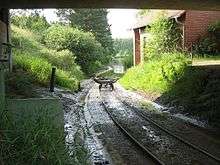

- Big Chute Marine Railway on the Trent-and-Severn-Waterway in Canada
- Swift Rapids Marine Railway on the Trent-and-Severn-Waterway in Canada
- Bude Canal in Cornwall
- Dahme Flood Relief Canal at Märkisch Buchholz in Germany
- Elbląg Canal between Elbląg and Ostróda in Poland
- Hay Inclined Plane in the Ironbridge Gorge, Shropshire
- Morris Canal, Northern New Jersey[12]
- St. Columb Canal built by John Edyvean
- Trench inclined plane on the Shrewsbury Canal, Shropshire
- Underground inclined plane in the Worsley Navigable Levels
See also
Further reading
- Tew, David (1984). Canal Inclines and Lifts. Sutton Books. ISBN 0-86299-031-9.
- Uhlemann, Hans-Joachim (2002). Canal lifts and inclines of the world (English Translation ed.). Internat. ISBN 0-9543181-1-0.
References
- 1 2 Foxton Locks and Inclined Plane A Detailed History. Department of Planning and Transportation, Leicestershire County Council. p. 3. ISBN 0-85022-191-9.
- 1 2 David Tew. Canal Inclines and Lifts.
- 1 2 3 4 Hans-Joachim Uhlemann. Canal Lifts and Inclines of the World.
- 1 2 Hadfield's British Canals eighth edition Joseph Boughey Page 49 ISBN 0-7509-0017-2
- 1 2 3 4 5 6 7 Permanent International Association of Navigation Congresses. (1989). Ship lifts: report of a Study Commission within the framework of Permanent ... PIANC. ISBN 978-2-87223-006-8. Retrieved 2011-12-14.
- ↑ David Minor (July 1996). "A CANAL CHRONOLOGY". EZnet. Archived from the original on 2011-12-16. Retrieved 2011-12-16.
1788 -- An inclined plane is used for the first time to raise canal boats, on England's Ketley Canal.
- ↑ H. W. Dickinson (1913). "Robert Fulton: Engineer and Artist". London Publishing. Archived from the original on 2011-12-16. Retrieved 2011-12-16.
- 1 2 "Railroad Extra, the Morris Canal and its Inclined Planes". Retrieved 2014-02-06.
- ↑ Raymond Bowen (2001). The Burry Port and Gwendreath Valley Railway and its Antecedent Canals. Oakwood Press. ISBN 0-85361-577-2.
- ↑ "Прохождение судами Енисейского пароходства судоподъемника Красноярской ГЭС - Фотогалерея". (Boats of the Yenisei Shipping Company traveling via the ship lift of the Krasnoyarsk Hydroelectric Station: Photo gallery) (Russian)
- ↑ From River to River - photo gallery, 2007
- ↑ "Photo Documentary of Morris Canal".
External links
- Article on the C & O incline plane
- Photo of St Louis-Arzviller inclined plane, Canal de La Marne au Rhin, Alsace-Lorraine, France
- Second photo of St Louis-Arzviller inclined plane
- The inclined plane of Ronquières (official site)
- Ronquières Inclined Plane
- Photos of Ronquières inclined plane
- Krasnoyarsk hydroelectric dam boat lift — photograph gallery showing all stages of ship elevation
- Funicular railways of the UK – Mainly concerning Funiculars but with a good section on canal inclined planes
- Overtoom – Dutch Overtoom page
- Avenhorn Overhaal
